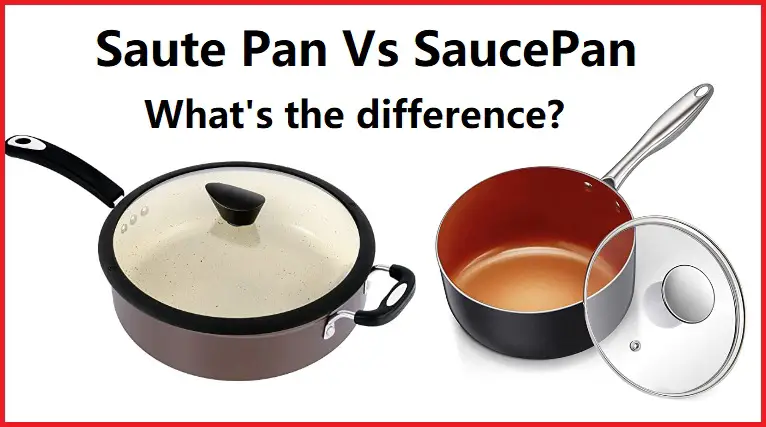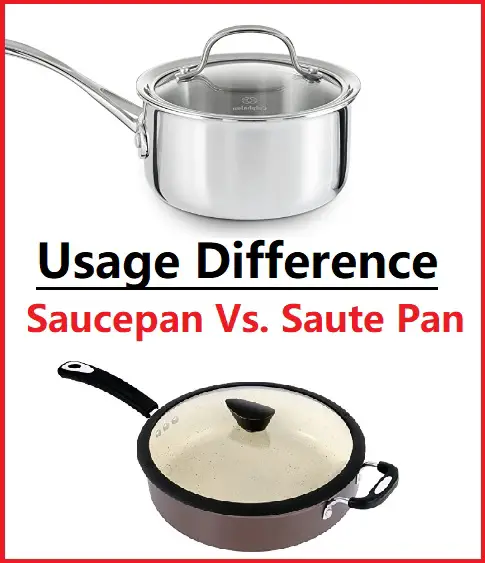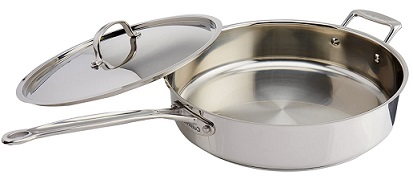
I am sure you have been in awe of the chefs who make it look easy to cook with sauté pans and saucepans. But isn’t it confusing to decide which one should you pick — a sauté pan or a saucepan? Can they be used interchangeably? Do they even have any difference? Which one should you have? I am going to answer all of these questions in this article.
Sauté Pan vs Sauce Pan
Let’s start with the design. A saucepan has a lid, a long handle, and straight edges. It is usually deep, and the sides are quite high. Whereas, a sauté pan has straight sides. It has a lid and a handle as well. It also offers a large surface area, but it is not too deep.
Amazon Best Selling Saucepan: Cuisinart MultiClad Pro Stainless Steel 1-1/2-Quart Saucepan

Usage Differences
A sauté pan is a staple in French kitchens. The word sauté originates from the French verb Sauter, which means jump. You must have noticed that food jumps in a sauté pan. Braising, poaching, searing, shallow-frying, sautéing, pan-frying are some of the common things you can do in a sauté pan. As the edges are a bit high, you can make sauces too. Saucepan, on the other hand, is mostly used for cooking techniques that need a lot of liquid like blanching vegetables. We usually reach out for a saucepan for boiling or stewing. It could be water for your coffee or the fantastic French sauces you want to make.

So the main difference between a saucepan and a sauté pan, is the design. The high walls of the saucepan help in boiling or cooking with a lot of liquid. Whereas, the low edges of the sauté pan aids in sautéing ingredients.
How to sauté in a saucepan?

Can you sauté in a saucepan? – This is a very common question, I face being a professional chef. The answer is yes! You can sauté in a saucepan HOWEVER, keep in mind some crucial things.
Any pan with high side walls is not apt for sautéing or using it as a sauté pan because high edges interfere with the evaporation process. Hence, the ingredients will get boiled rather than caramelized. To use a sauce pan for sautéing, you need to make sure the amount of ingredients is less. If you are not crowding the pan, then the evaporation may take place well and the end result will be tasty sautéed food.
Also, saucepans with lower capacity are more efficient for sautéing, due to their not so high edges. Additionally choose an oil with a low smoking point like extra virgin olive oil or butter. Low smoking point means even in low heat the oil gets hot easily. This will aid in faster evaporation and better searing. And using a sauté pan as a sauce pan is easy, however the capacity of the sauté pan will decide your limit.
Amazon Best Selling: Cuisinart Chef’s Classic Stainless 5-1/2-Quart Sauté Pan

Sauté pan Vs Sauce pan – Buying the most useful one

In this section, we will discuss and understand the differences between the two in detail, if you want to pick one. So let me tell you all you need to know in the saute pan vs. saucepan debate. This will help you to make a reasoned decision before you bring one home.
Understanding Size and Capacity
When deciding between sauté pan vs. saucepan, the size and capacity are crucial factors. How else will you know which if the capacity of the saucepan is enough to cook oatmeal for a family of four? Or if your sauté pan size is adequate for searing two duck breasts?
Saucepans are usually available in two sizes. Smaller saucepans hold anywhere between 1 to 2.5 quarts. These are good for making single servings or cooking for a small family. Larger saucepans can hold between 3 to 4 quarts. These are good as larger stockpots. Both small and large saucepans come with tight-fitting handles to prevent heat from escaping.
In the case of sauté pans, you can find anything between 1 to 7 quarts. Some brands also sell half-sizes. If you have to cook for a small family, a sauté pan of 3 or 4 quarts is useful. But is it possible to differentiate between a sauté pan and a saucepan based on capacity? What other factors should you take into account?
Material Choices:
The first factor to consider when you are in a fix between sauté pan vs. saucepan is the material. Stainless steel is the most popular material for saucepans. You can also find copper, aluminum, and carbon steel saucepans in the market.
For sauté pans, the preferred material is stainless steel, copper, aluminum, anodized aluminum, and carbon steel. These days many prefer cast iron or enameled sauté pans too. Stainless steel saucepans and sauté pans are popular due to their heat retention capabilities. Aluminum and copper are also excellent conductors of heat. However, you need to regulate the temperature well to prevent the food from burning.
When it comes to metallic cookware, reactivity with food also matters. It can make a massive difference in the taste or color of the food. After all, you don’t want the metal to leach into your food. For example, stainless steel is completely non-reactive. But copper, aluminum, and cast iron are very reactive. So you need to be careful about cooking acidic food items in these.
Cleaning and Ease of Use
You can never decide on purchasing a piece of cooking equipment without knowing how easy it is to use and clean. If you pick up a piece of cookware that is extremely difficult to clean, the chances are that you will seldom reach out for that during your culinary adventures. In the case of sauté pan vs. saucepan, this factor becomes even more critical.
Let’s look at sauté pans first. A non-stick sauté pan is the easiest to use. However, you can’t place it in the dishwasher or the oven. You need to use special spatulas for cooking in these sauté pans.
In comparison, stainless steel sauté pan or cast iron sauté pans are more versatile. These are oven and dishwasher friendly. However, these can be really heavy for everyday use. If we consider saucepans, stainless steel, copper, and aluminum saucepans are easy to use. But they are extremely difficult to clean without heavily scrubbing the corners or soaking. But soaking metals can affect their quality in the long run.
Price Comparison:
I am sure that you must have come across a wide range of pricing options while looking for sauté pans and saucepans. Are sauté pans more expensive than saucepans? Is it mandatory to buy a costly saucepan for the best results?
The price of sauté pans and saucepans depends on various factors. Cookware that retains heat very well is more popular. That’s why a USD 200 copper saucepan may be preferred over a USD 15 non-stick sauté pan since copper is a great conductor of heat.
The construction of the cookware also affects the price. If you look at sautéing pans or saucepans from well-known brands, they have a sturdy built and don’t get damaged when dropped. Even the handles are more ergonomic for a better grip.
When you examine sauté pan vs. saucepan from the perspective of price point, the bottom line is simple. If you go for cheaper sauté pans or saucepans, you may face issues with heat retention and construction. Expensive ones are more durable and offer better results.
My Verdict
Now that we have considered several factors, it is worth remembering that there are distinct features that make saucepans different from sauté pans. If you are looking at a lot of shallow frying, braising, or poaching in your cooking, sauté pans are a good option.
Saucepans are more suited for reducing sauces or stewing. So can you sauté in a saucepan? I wouldn’t recommend it because there is a risk of burning your food or the food sticking to the surface. In case you don’t have one, try sautéing in the saucepan while following my above guidelines.
As both saucepans and sauté pans are essential cookware for your kitchen, I wouldn’t recommend using them interchangeably. Different styles of cooking need different cookware. For great results in your cooking, it is essential to use cookware for its designated purpose.
The depth of a saucepan offers several advantages over a sauté pan when you make sauces and soups that need a lot of stirring. If you rarely make sauces but love shallow-frying, you should get a sauté pan.
So wrapping up, if you love to experiment in the kitchen, both a sauté pan and saucepan can help. If you are a beginner, pick one depending on your cooking style. Ultimately, your requirements in the kitchen determine what you need.
